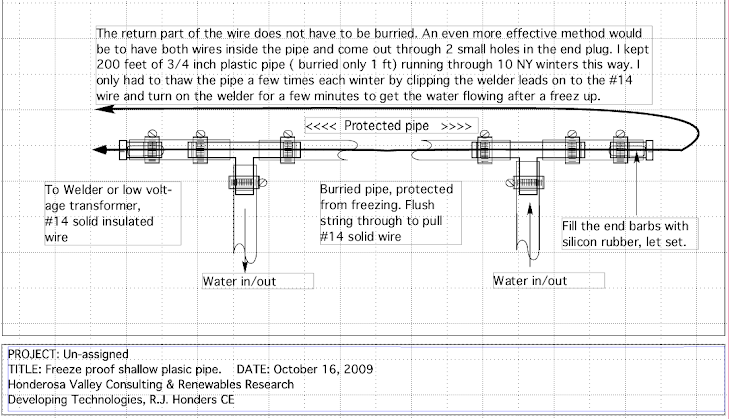I was wondering if you might have a suggestion on how to get an above ground water line from an Artisian well to NOT FREEZE. This is the water source for the ducks and chickens, and am looking for a way to keep it from freezing over.
First, a couple of assumptions. I assume that the water pipe is made of black plastic, and is gravity fed from the artesian well that you mention.
Depending on just how long the pipe is and where there is a 120VAC outlet to plug in a (400 to 600 Watt 12V) landscape lighting transformer in relation to one end of the pipe, the following will vary somewhat. The idea is to PUT THE HEAT INSIDE THE PIPE. You may also want to insulate the pipe.
You will need a length of 18 to 24 gauge twisted 2 wire, solid, insulated, 'bell' or 'thermostat' wire as long as your pipe plus 5 to 10 feet to reach the transformer and snake it through (inside) the whole length of the pipe. This is best done by first flushing a strong nylon pull string through the pipe with which you can pull the twisted wire pair through the pipe. At the well end have at least 6 inches of wire out the end and folded down over the edge and taped to the outside of the pipe to keep it from pulling back. Strip the wire ends here and twist the bare wire together securely and tape.
At the down hill end, (unless the pipe is just open ended and running all the time which might keep it from freezing all by it self ) drill a small 3/16" hole in the pipe, 3 inches back from the shutoff valve, and have the extra 5-10 feet of wire come out here. Seal around the hole and wire with silicone rubber and tape over the wire and hole to seal and provide strain relief for the delicate wire. It is best to have this valved end fastened to a 2X4 staked in the ground.
Next, connect the 2 wires to the 12V terminals on the landscape lighting transformer. If you just want to thaw out the pipe on occasion then you can just plug in for a few minutes to thaw it out, or maybe use a timer to turn the transformer off afterwards incase you forget. A safer method would be to use a ceiling fan control or lamp dimmer built into a standard electrical box/outlet plug the transformer into. Now you can adjust the power to the wire in the pipe to just keep it thawed and not use more electricity than you have to. I would also connect a 12V lamp at the transformer terminals (with the wires) so you have an indication of power flow to the wires (brighter bulb more heat to the wire/pipe).
Use heavier wire for longer runs, ie 18 Ga for 100', 24 Ga for <30'. If your pipe still freezes during very cold nights (T<20°F) you will have to insulate ( or bury) the pipe as well or use a larger transformer like 1000 Watts at 12V. You can get all this hardware at Lowes or Home Depot. Pictured below is a way to do a pressurized system.
I had to answer this suggestion if only to keep this guy out of trouble.
I had to answer this suggestion if only to keep this guy out of trouble.
Radiators that can run COLD in hot weather, now THAT is an interesting and totally new idea you should patent it!
PS sorry if that last remark seemed sarcastic, it wasn't meant to, I really mean I have never seen a system where the radiators produce 'cool'.
I have tried running cold water through existing radiators as well as radiant heat pipes embedded in my floor. The problem is the condensation from the sometimes very humid air in the summer here in NY. Puddles form under radiators and cool floors will become wet with condensation.
I solved those problems by running the cold spring water, gravity fed, through an 'A' coil like heat exchanger (radiator) with a condensation collection pan and drain. A small fan / blower blows the room air through the A coil thus cooling the room. Almost free air conditioning.










2 comments:
Great way to keep a water pipe from freezing, I was wondering would a 14 ga copper wire looped back inside the 200' 1" pipe be big enough to heat the water in the pipe, and would any 1000 watt 12 volt transformer do the job, and can I use a dimmer on the transformer? pipe will be buried about 24" except where it comes out of the ground and into garage. I'm in Maine so it gets pretty cold, Thank You
Yes Ken, 400 feet of #14 solid copper, plastic insulated wire has a resistance of 0.25250 ohms per 100 feet. So you would have 1.01 Ohms in your circuit. If the pipe is insulated even a little, I suspect you could cut the power back to around 50 Watts and keep it from freezing. So you'll need to find a 12V, 150 Watt (min) transformer. You could use a ceiling fan (inductive) control on the transformer primary to fine tune the power input to just keep the water from freezing and not waste a lot of power over-heating the water. Check the water temp after it has sat still overnight probably should be around 40°F when it is really cold outside.
If you use a welding transformer you should limit the current to about 24 Amps so you would need to apply about 24A X 1.01Ω=24.24V for a power input of ~580 Watts which should be enough to thaw the pipe in a few minutes even if frozen solid.
Post a Comment